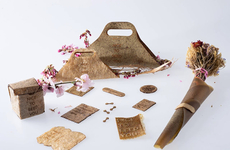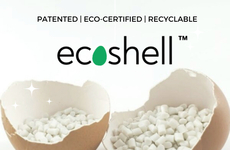
Shellworks Creates Recyclable Bioplastic from Lobster Shells
Laura McQuarrie — February 22, 2019 — Eco
References: theshellworks & dezeen
A desire to make the most of the conveniences of plastic and better support the environment is inspiring some forward-thinking companies to turn their attention to sustainable materials like biodegradable and recyclable bioplastic.
A group of four designers from the Royal College of Art and Imperial College teamed up to develop a project called Shellworks, which uses a series of machines and seafood waste to create bioplastic objects. The material, made from the shells of crustaceans, forms a paper-like material that has the potential to replace conventional single-use plastics. Due to the makeup of the material, its stiffness and flexibility can be changed based on the need of the object.
In all, five machines are used to create the recyclable bioplastic materials: Shelly, Sheety, Vaccy, Dippy and Drippy.
A group of four designers from the Royal College of Art and Imperial College teamed up to develop a project called Shellworks, which uses a series of machines and seafood waste to create bioplastic objects. The material, made from the shells of crustaceans, forms a paper-like material that has the potential to replace conventional single-use plastics. Due to the makeup of the material, its stiffness and flexibility can be changed based on the need of the object.
In all, five machines are used to create the recyclable bioplastic materials: Shelly, Sheety, Vaccy, Dippy and Drippy.
Trend Themes
1. Recyclable Bioplastics - The trend towards biodegradable and recyclable bioplastics for single-use plastics presents an opportunity for innovation in the materials industry.
2. Sustainable Materials - The use of sustainable materials, such as bioplastics, is becoming increasingly important and presents opportunities for innovation in packaging and product design industries.
3. Waste Utilization - The trend towards utilizing waste materials, such as seafood waste in the creation of bioplastics, presents opportunities for innovation in waste management and manufacturing industries.
Industry Implications
1. Packaging - The use of recyclable bioplastics presents an opportunity for innovation in the packaging industry, particularly in the creation of sustainable and environmentally friendly packaging solutions.
2. Product Design - The use of sustainable materials, such as biodegradable and recyclable bioplastics, presents an opportunity for innovation in product design, particularly in the creation of environmentally friendly and sustainable products.
3. Waste Management - The trend towards utilizing waste materials, such as seafood waste, in the creation of bioplastics presents an opportunity for innovation in the waste management industry, particularly in the creation of more efficient and environmentally friendly waste management solutions.
3.6
Score
Popularity
Activity
Freshness















